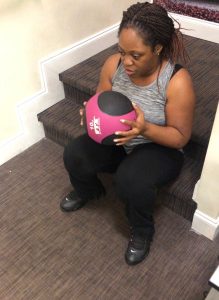Regardless of the type of person, conditioning a new client is essential for assessing their fitness level and potential. Only then can I construct an exercise program that is tailored to them specifically.
In the world of personal training fitness professionals encounter a myriad of clients. Some of these clients know absolutely nothing about the way to go about training properly and others can teach the professionals a thing or two.
What’s the first step?
Test Cardiovascular Ability
Being an avid runner myself I know the importance that my cardiovascular capability has on areas of my fitness. As this relates to the client, the initial two weeks of training I have my client(s) either walk/jog/run on a treadmill with varying speeds and inclines.
This allows me to gauge the intensity and speeds at which the client(s) starts to tire and for what duration. This is the early phases of creating an exercise program for a client.
After years of working out myself and being a fitness professional, I have seen a strong correlation with one’s cardiovascular strength and their physical. Clients whom I have encountered with stronger profiles tend to have more:
- Leg Strength – better at executing leg routines, such as squats, lunges, and deadlifts
- Arm Strength – better at executing upper body workouts, such as pushups, bicep curls, and dumbell (or barbell) rows
- Core Strength -better at executing abdominal moves, such as planks, crunches, and leg raises
Those are just to name a few. A pretty popular saying in the running community is that “a runner can do anything.” Why is that? Because running requires that one uses virtually everyone muscle in the body to do so.
This makes the body that much more efficient at pretty much every move, whether it’s pulling something (rows), pushing something (pushups) or lifting something off the ground (deadlifts).
Perform Basic Moves
After using the cardio “fitness measuring stick” to assess a client(s) ability, then it’s time for some beginner moves. The infamous squat is a highly popular move in that it targets the larger leg muscles including the back and core areas: no weight required. I typically have my client(s) start off with a bare squat move of sitting down on a low surface (bench, chair, or stairs).

This move is usually done with no resistance but some clients may need that extra “pull”. This is because the client can slightly move the weight forward and use that momentum to return to the upright starting position of the squat.
This squat move helps the client understanding the basics of the “up and down” motion of the squat. After the client’s comfort level and ease of performing this move has increased we can move to perfecting that squat form and soon enough to adding resistance.
The latest fitness trend is new and highly complex moves which is great to add variety and switch things up. However, there is a place and time for more complex and advanced moves.
No matter how excited so I am a fitness professional to showcase my talents it is essential to conditioning clients first. This assures they are able to execute the bare movements and motions is vital before moving to the “big boy” and “big girl” moves.
Taking this approach demonstrates your range and flexibility as a trainer AND exhibits a key trait all great trainers must possess: patience.
How do you start sessions with new clients and assess them?
[info type=”facebook”]Join the Facebook Community Group to meet other trainers.[/info]
Mr. Dassin is an NFPT certified trainer, NFPT author, and fitness model. A staunch humanitarian and intellectual, Stephen boasts over 15 years of experience in the areas of health and fitness. Stephen’s approach to personal training is methodical in nature; his methods take an interpersonal and scientific based view of the connections of the human mind and the human anatomy and it’s capabilities. His passion for fitness is unparalleled. His athletic background fueled his poise in becoming knowledgeable about nutrition as well. This added fuel to his desire to help others achieve their own individual goals in the area of fitness such as himself. Join Stephen on his journey, not just a fitness journey but the greatest journey of them all: Life.

